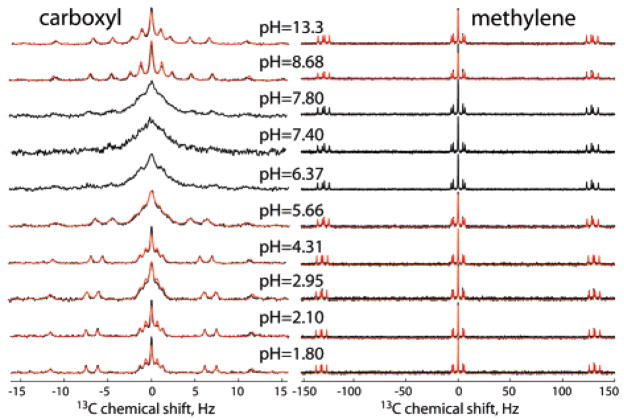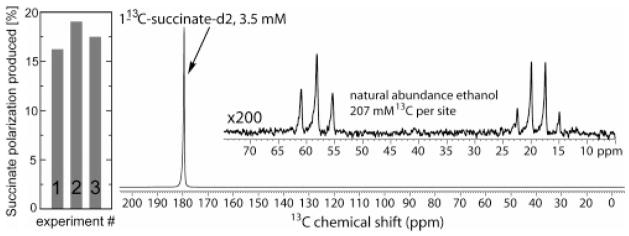One of the major shortcomings of NMR is poor sensitivity, which limits imaging of molecular concentrations in vivo to the millimolar level. Both DNP (dynamic nuclear polarization)1 and PASADENA (parahydrogen and synthesis allow dramatically enhanced nuclear alignment)2,3 have recently4–11 been demonstrated to reach spin polarization of order unity on 13C sites with spin-lattice relaxation time T1 in the range of tens of seconds. This is a signal enhancement by a factor of ~100 000 on currently utilized MRI scanners. Exploring the potential for fast in vivo 13C imaging and spectroscopy is a principal motivation in these studies. While DNP was recently successfully applied to several metabolically relevant compounds including 1-13C-pyruvic acid,9,11 PASADENA at comparable polarization was demonstrated only with the ether 2-hydroxyethyl-propionate, which has no metabolic relevance. Recently, we have demonstrated with NMR and fast MRI the use of disodium 1-13C-acetylenedicarboxylate (ADC) as a precursor to hyperpolarized1-13C-succinate5 via the molecular addition of parahydrogen. However, that chemical approach suffered from (i) a short spin-lattice relaxation time T1 of 6 s, (ii) toxicity of the precursor ADC and intermediate maleate, which is relevant if hydrogenation is incomplete, and (iii) polarization of only several percent.5 The system described here overcomes these shortcomings.
We used 1-13C-fumaric acid-d2 as the unsaturated PASADENA precursor for the molecular addition of dihydrogen (Figure 1). In order to break the magnetic equivalence and simplify the spin dynamics, the 13C label is confined to only one carboxyl site (C1) in this otherwise symmetric molecule. The choice of an unprotonated carbon maximizes T1 for the hyperpolarized product species. Deuteration of the precursor at the positions 2 and 3 in the present approach (Figure 1) enables the increase of the crucial product T1 from 6 s (no deuteration) to 27 s (pH 3 and pH 7). A further increase to 39 s (pH = 3) and 56 s (pH = 7) was observed when the solvent was D2O. After molecular addition of parahydrogen, an efficient transfer of spin order from the nascent protons to a third spin2,7,8 requires precise information about the J-couplings among the three nuclei of succinate highlighted in red in Figure 1. A strong dependence of the couplings on pH has been reported12 due to the changing probabilities of the interconverting neutral, anion, and dianion forms. We were motivated to revisit this problem with 1H coupled 13C spectroscopy of natural abundance succinic acid, since spectra needed to extract the couplings and dephasing of the three spins of interest here were not reported. The fits of 13C multiplet patterns of C1 and C2 carbons (Figure 2) provide sufficient spectroscopic information for elucidation of these couplings. We also report in Table 1 the distinct 3JHaHc coupling present in the absence of the deuteration of Figure 1. The simulated spectra were calculated by GAMMA,13 and the fits were optimized by MATLAB using the Levenberg-Marquardt algorithm. The fitting of 1JCH and 2JCH couplings to C2, 2JCH and 3JCH couplings to C1, and the two 3JHH couplings between protons was performed simultaneously. Distinct dephasing times T2 for C1 and C2 were allowed in the fitting. We find (Figure 2) that the C1 spectrum of the dicarboxylic succinic acid shows line broadening characteristic of intermediate chemical exchange, precluding accurate extraction of the J couplings at a pH near the two pKa values. As a result of this finding we choose to transfer spin order at pH ≪ pKa, where the J-couplings necessary for PASADENA are best resolved.
Figure 1.
Cis molecular addition of parahydrogen to 1-13C-fumaric acid-d2 to produce 1-13C-succinic acid-d2. The catalytic reaction was carried out at 62 °C in H2O or D2O with substrate concentrations of 1–5 mM.
Figure 2.
13C NMR multiplets (experimental in black and simulated fits in red) of natural abundance succinic acid at various pH. All spectra acquired at 14 T with 128–512 scans using Varian triple resonance H/C/N probe without 1H decoupling.
Table 1.
J Couplings of 13C1 and the Protons in Positions 2 and 3 in 1-13C-succinic Acid; the Site Labels Are in Figure 1
| pH | 2JCH (Hz) | 3JCH (Hz) | 3JHaHc (Hz) | 3JHaHb (Hz) |
|---|---|---|---|---|
| 1.80 | −7.15 | 5.84 | 5.43 | 7.45 |
| 2.10 | −7.16 | 5.83 | 5.42 | 7.56 |
| 2.95 | −7.15 | 5.82 | 5.62 | 7.41 |
| 4.31 | −6.80 | 5.47 | 6.07 | 7.35 |
| 5.66 | −6.41 | 4.48 | 7.55 | 7.17 |
| 8.68 | −6.61 | 4.20 | 8.69 | 6.62 |
| 13.3 | −6.32 | 4.13 | 8.51 | 6.68 |
Instrumentation for parahydrogen addition and transfer of spin order to 13C in an auxiliary low field magnet has been previously described.6,8,10 Here we used a modified version in which the antechamber, chemical reactor, sprayer, and all connecting tubing were replaced by acid resistant parts eliminating any possible direct contact of chemical mixture with stainless steel or copper to prevent corrosion. The hydrogenation catalyst, 2.5 mM Rh norbornadiene bisphosphine, was prepared on site using a 5% molar excess of 1,4-bis[(phenyl-3-propanesulfonate)phosphate butane disodium salt (Sigma-Aldrich/Isotec, Miamisburg, OH) relative to bis(norbornadiene)rhodium(I) tetrafluoroborate (Strem Chemicals, Newburyport, MA, 96% purity) in ultrapure water (Millipore Super-Q Plus System). Degassed catalyst solution was mixed with 1-13C-fumaric acid-d2 (Cambridge Isotope Laboratories, 96% d, 99% 13C) and acidified with sodium phosphate buffer to pH = 2.9 with a 50 mM final buffer concentration. Hydrogenation was conducted as previously described5,6,8,10 at 62 °C by spraying 1-13C-fumaric acid-d2 in aqueous catalyst solution into 10 bar of H2 (97% para) resulting in >95% chemical conversion as shown by 13C solution NMR spectroscopy at 14 T. The 1H decoupling pulses were applied for 4 s to preserve spin order in the singlet state while the reaction occurs.7,14 The spin order was transferred from 1H nuclei to 13C at 1.76 mT in the reactor by the heteronuclear pulse sequence described by Goldman and Jóhannesson7 using 2JCH =−7.15 Hz, 3JCH = 5.82 Hz, and 3JHH = 7.41 Hz to determine the pulse timing. The resulting hyperpolarized product was automatically delivered to an NMR/MRI scanner and detected at 4.7 T 25 s after production. Figure 3 demonstrates the 13C spectrum of hyperpolarized 1-13C-succinate-d2 at pH = 2.9 (resonance at ~180 ppm). A reference spectrum from natural abundance ethanol (insert of Figure 3) was used to calibrate the polarization. A T1 value of 26.6 ± 1 s was measured by both inversion recovery method of 1-13C-succinate-d2 at Boltzmann polarization and using hyperpolarized material and small angle excitation pulses of ~5°. A 13C hyperpolarization at the output of the reactor of 15–20% was consistently achieved (Figure 3).
Figure 3.
Typical 13C spectrum of 3.5 mM 1-13C-succinate-d2 hyperpo-larized at pH = 2.9. The chart on the left shows the typical reproducibility achieved; a series of three experiments was conducted within 30 min yielding 17.6 ± 1.4% polarization. Natural abundance ethanol with 207 mM of 13C per carbon site is used as a reference. Spectra are acquired at 4.7 T with a Bruker Avance console and home-built double resonant probe.15
The achievement of hyperpolarization of order unity in this metabolically relevant system is encouraging for further development of PASADENA which is unique among hyperpolarization methods in its combination of effectiveness, speed, and the simplicity of the apparatus. Under the present conditions, the signal arises from those product molecules that are formed in 4 s in the low field reactor, as evidenced by the nearly complete loss of hyperpolarization if the low field pulse sequence is delivered off resonance. In principle, the theoretical limit is nearly 100% for 13C hyperpolarization in this system, and it is a promising one for elucidating the interplay of coherent and incoherent spin evolution and chemical reaction, providing a quantitative understanding and optimization of the several steps.
The present strategy of using low pH to minimize relaxation by chemical exchange and partial deuteration of both metabolite and solvent to increase T1 demonstrates a route to efficient PASADENA hyperpolarization applicable to many carboxylic acids. The 13C label introduced as 1-13C-succinate was shown to be a biomarker, distinguishing a brain tumor, with its compromised blood-brain barrier, from normal tissue.5 Thus, the location and status of a tumor can be potentially interrogated in situ with hyperpolarized succinate. The long T1 suggests feasible delivery of hyperpolarization also to cells and tissue which normally take up and metabolize succinate. Information on the first minutes of metabolism is scarce but encouraging. If we multiply the rate of succinate uptake and metabolism per unit volume of rat kidney16 by the C1 T1 measured here in H2O, we obtain 2 mM as a semiquantitative measure of the concentration of hyperpolarized molecules available for detection. The signal from this pool of intracellular molecules will still be enhanced by ~104 and thus detectable without signal averaging in diverse situations. The details of their fate may be influenced by the fact that certain enzymatic reactions which transfer hydrogen atoms are often substantially slower when transferring deuterium,17 but this difference in kinetics for some reactions does not prevent the metabolism of deuterated molecules serving as a fingerprint of the state of cells or tissues. Further work is needed to estimate the time-dependent spectrum of daughter molecules, but the present results and analysis suggest that the signal-to-noise ratio will be adequate to follow the early steps of metabolism in vivo with unprecedented spatial and time resolution.
Acknowledgments
We would like to thank Rudi Schulte Research Institute (RSRI), NIH 1R21 CA118509, NCI, James G. Boswell Fellowship, American Heart Association, American Brain Tumor Association, Beckman Institute Pilot Program (California Institute of Technology), Dr. William Opel for support of the PASADENA program at HMRI, and Dr. Keiko Kanamori (HMRI). We also thank Dr. Scott Ross for providing convenient access to a 14T Varian solution NMR spectrometer at Caltech. The PASA-DENA polarizer was provided under loan agreement between HMRI and GE Healthcare established by Dr. Klaes Golman, Ms. Marivi Mendizabal, and Dr. J.-H. Ardenkjaer-Larsen.
References
- 1.Abragam A, Goldman M. Rep Prog Phys. 1978;41:395–467. [Google Scholar]
- 2.Bowers CR, Weitekamp DP. Phys Rev Lett. 1986;57:2645–2648. doi: 10.1103/PhysRevLett.57.2645. [DOI] [PubMed] [Google Scholar]
- 3.Bowers CR, Weitekamp DP. J Am Chem Soc. 1987;109:5541–5542. [Google Scholar]
- 4.Ardenkjaer-Larsen JH, Fridlund B, Gram A, Hansson G, Hansson L, Lerche MH, Servin R, Thaning M, Golman K. Proc Natl Acad Sci. 2003;100:10158–10163. doi: 10.1073/pnas.1733835100. [DOI] [PMC free article] [PubMed] [Google Scholar]
- 5.Bhattacharya P, Chekmenev EY, Perman WH, Harris KC, Lin AP, Norton VA, Tan CT, Ross BD, Weitekamp DP. J Magn Reson. 2007;186:108–113. doi: 10.1016/j.jmr.2007.01.017. [DOI] [PMC free article] [PubMed] [Google Scholar]
- 6.Bhattacharya P, Harris K, Lin AP, Mansson M, Norton VA, Perman WH, Weitekamp DP, Ross BD. Magn Reson Mat Phys Biol Med. 2005;18:245–256. doi: 10.1007/s10334-005-0007-x. [DOI] [PubMed] [Google Scholar]
- 7.Goldman M, Johannesson H, Axelsson O, Karlsson M. J Magn Reson Imaging. 2005;23:153–157. doi: 10.1016/j.mri.2004.11.031. [DOI] [PubMed] [Google Scholar]
- 8.Goldman M, Johannesson H, Axelsson O, Karlsson M. C R Chimie. 2006;9:357–363. [Google Scholar]
- 9.Golman K, Petersson JS. Acad Radiol. 2006;13:932–942. doi: 10.1016/j.acra.2006.06.001. [DOI] [PubMed] [Google Scholar]
- 10.Johannesson H, Axelsson O, Karlsson M. C R Physique. 2004;5:315–324. [Google Scholar]
- 11.Kohler SJ, Yen Y, Wolber J, in’t Zandt R, Gram A, Ellner F, Thaning M, Chen A, Albers M, Bok R, Tropp J, Nelson S, Vigneron D, Kurhanewicz J, Hurd R. Proc Int Soc Magn Reson Med. 2006;14:128. [Google Scholar]
- 12.Lit ES, Mallon FK, Tsai HY, Roberts JD. J Am Chem Soc. 1993;115:9563–9567. [Google Scholar]
- 13.Smith SA, Levante TO, Meier BH, Ernst RR. J Magn Reson Ser A. 1994;106:75–105. [Google Scholar]
- 14.Carravetta M, Levitt MH. J Am Chem Soc. 2004;126:6228–6229. doi: 10.1021/ja0490931. [DOI] [PubMed] [Google Scholar]
- 15.Zhang QW, Zhang H, Lakshmi KV, Lee DK, Bradley CH, Wittebort RJ. J Magn Reson. 1998;132:167–171. [Google Scholar]
- 16.Nishiitsutsuji JM, Ross BD, Krebs HA. Biochem J. 1967;103:852. doi: 10.1042/bj1030852. [DOI] [PMC free article] [PubMed] [Google Scholar]
- 17.Pu JZ, Gao JL, Truhlar DG. Chem Rev. 2006;106:3140–3169. doi: 10.1021/cr050308e. [DOI] [PMC free article] [PubMed] [Google Scholar]





